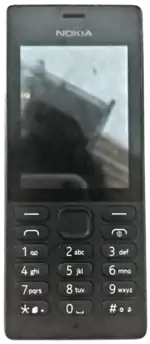Series 30+
Series 30+ (abbreviated as S30+) is a software platform and application user interface used for Nokia-branded mobile devices. The platform was introduced by Nokia in September 2013, first appearing on the Nokia 108, and has been the main Nokia feature phone operating system after the end of the Series 30 and Series 40 platforms in 2014. Despite the similar name and user interface, S30+ is technically completely different and unrelated to S30.
 Nokia 150, which runs Series 30+ | |
| Brand | Nokia |
|---|---|
| Developer | Nokia (2013-2014) Microsoft (2014-2016) HMD Global (2016-present) |
| First released | 2013 |
| Predecessor | Series 30 and Series 40 |
| Type | feature phone |
| Operating system | Series 30+ (MediaTek) |
| System on chip | MediaTek (ARM) |
| Memory | Depends on model |
| Rear camera | Depends on model |
Many S30+ devices only support MAUI Runtime Environment (MRE),[1][2] developed by MediaTek,[3][4] but some later devices have included support for J2ME applications. Even for models that don't support Java J2ME applications, some are still capable of running Some S30+ models also come with an online shop that would allow downloading new apps and games.[5]
List of devices
The following feature phones use the Series 30+ platform and are all available as both single and Dual SIM models.
Made by Nokia
- Nokia 108 released in 2013 is a Series 30+ based device with support for camera, video and Bluetooth technology.
- Nokia 220 was released in 2014 with 2.4-inch display and having Nokia Xpress browser and GPRS data connection (2.5G).
- Nokia 225, released in 2014, is similar to the 220 but has a larger 2.8-inch display.
Made by Microsoft
- Nokia 130 is a smaller device with a 1.8-inch display, also released in 2014.[6]
- Nokia 215 was announced in January 2015. Like the 220, the 215 has a 2.4-inch display, has GPRS – EDGE connectivity and only has a VGA camera.[7]
- Nokia 105 (2015) is a device announced in June 2015, it notably had increased storage and could store over 2.000 contacts and last 35 days on standby, and is advertised as a "back up telephone" for smartphone users.[8]
- Nokia 222 is a device announced in August 2015. The differentiation from its predecessors is that it comes with Skype's GroupMe application preinstalled,[9] supports J2ME applications.
- Nokia 230 launched in November 2015. This device features front facing and main camera both with LED flash.[10]
- Nokia 216 was announced in September 2016 and released in October 2016 (first released in India and Vietnam, later in the United Kingdom in January 2017). It is identical in features to the Nokia 215 with the main difference being the front facing camera and a slight redesign.[11]
- Microsoft-branded phone with a part number RM-1182 was reportedly developed in 2015. Photos surfaced in 2018 showed a redesigned user interface, featuring elements of Windows 10 Mobile design language and Microsoft Account integration.[12]
Made by HMD
- Nokia 150 was launched on 13 December 2016. It looks like a Nokia 216 but excludes a front camera and flash, uses a different processor, only has 6 ringtones in Tones, and has a matte finish around the keypad (as opposed to the glossy finish around the keypad on the Nokia 216). It still features Bluetooth, but lacks the ability to access the internet.
- Nokia 3310 (2017) in 2G was announced on 26 February 2017. The Series 30+ is integrated only on the 2G version.
- Nokia 105 (2017) was announced on 17 July 2017.
- Nokia 130 (2017) was announced on 17 July 2017.
- Nokia 106 (2018) was announced on 14 November 2018.
- Nokia 210 (2019) was announced on 25 February 2019.
- Nokia 105 (2019) was announced on 24 July 2019.
- Nokia 110 (2019) was announced on 5 September 2019.
- Nokia 5310 (2020) was announced on 19 March 2020.[13]
- Nokia 125 was announced on 12 May 2020.[14]
- Nokia 150 (2020) was announced on 12 May 2020.[14]
Multimedia support
Maximum accepted video resolution is 854×480.
- Accepted video containers: AVI, MP4, 3GP, 3G2
- Accepted video codecs: DivX 4, DivX 5, XviD, H.263, MJPEG
- Accepted audio containers and codecs: MP3, WAV (PCM and ADPCM variants only), AAC,[15] AAC+[15] (poor), eAAC+[15] (poor), AMR-NB, MIDI (no larger than 20 KB)
- Accepted photo formats: JPEG, GIF, PNG, BMP
References
- "Installing Apps in Nokia 225 and 220 - Get Cool Tricks". 20 January 2015.
- "Nokia Redirection App". discussions.nokia.com. Archived from the original on 26 June 2015.
- "What is MRE?". MediaTek. Archived from the original on 4 November 2015.
- "The new Nokia 3310: Part 1". CCL. Archived from the original on 8 October 2018.
- "Nokia 3310 hands-on: It's hard not to like this modern take on the feature phone".
- "Nokia 130 Specification". Archived from the original on 6 January 2015.
- "Nokia 215 and 215 dual sim". Archived from the original on 5 January 2015.
- R., Rahul (8 June 2015). "Microsoft's new Nokia 105: Why the $20 Nokia Series 30+ feature phone is a must buy in the smartphone era". International Business Times – United Kingdom.
- Pratap, Ketan (25 August 2015). "Nokia 222 and Nokia 222 Dual SIM Feature Phones Launched". NDTV - Gadgets.
- "Microsoft Unveils Budget-Friendly Selfie Smartphone 'Nokia 230'". KDramaStars. 29 November 2015. Retrieved 30 November 2015.
- https://www.microsoft.com/en/mobile/phone/216/
- Bowden, Zac (20 December 2018). "Microsoft almost made a feature phone that looked like Windows Phone". Windows Central. Archived from the original on 26 May 2019. Retrieved 26 May 2019.
- "The next Nokia remake is the XpressMusic-branded 5310". engadget.com. 19 March 2020.
- https://m.gsmarena.com/nokia_125_and_150_feature_phones_announced-news-43156.php
- Doesn't support files with M4A container